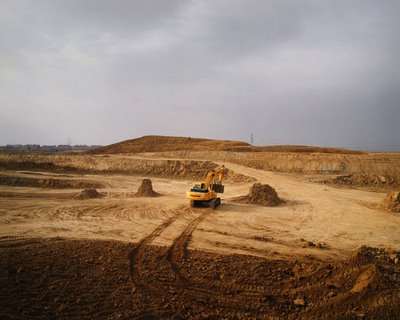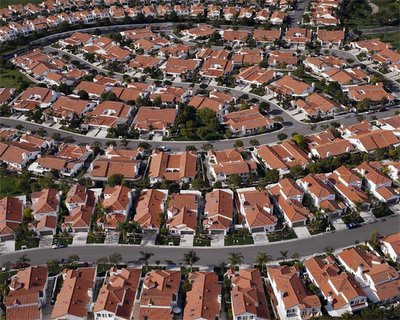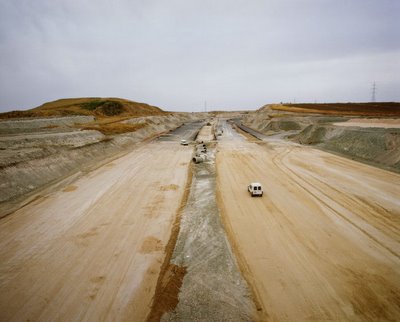Suburban earthworks

With genuine excitement I discovered the photography of Sergio Belinchón today, and excerpts from his series "Suburbia" (2002) appear both above and below.

This is the earth immediately before the suburbs arrive, a planet stripped of its identity, prepared to accept housing, made ready for sprawl and subdivisions, human development; soil scraped down to rock, topography tilled, erased clear and reset back to graveled virginity so it can host our lawns and cul-de-sacs.
The earth as passive medium.



Like something between a Michael Heizer earthwork and a kind of pre-Aztec, sacred desert landscape – the Nazca lines, perhaps, ritually repaved – one could be excused for wishing that this preparatory stage could somehow last forever.
An endless topographical sculpture we could somehow also live within: forever moving earth from one lot to another; forever rearranging the labyrinth of abstract forms; forever exploring new combinations of infrastructure.
Yet even after the houses arrive, that's what these suburbs continue to be; the earthwork doesn't go away. These sewered tumuli and landscaped berms are just buried by grass and driveways.

To live in the suburbs is to live in a monumental earthwork sculpture. We just tend, after a certain point, not to see it.

In a recent review of Robert Bruegmann's Sprawl: A Compact History, Witold Rybczynski reminds us that any argument about America being choked to death by limitless, amnesiac sprawl while Europe is sitting pretty amidst history-rich urban density (an argument I make all the time), is actually totally flawed.
That argument – my argument – ignores the built reality.
"Yet haven't high rates of automobile ownership, easy availability of land, and a lack of central planning made sprawl much worse in the United States?" you might ask.
Well, most Americans seem to be "unaware that suburbs now constitute the bulk of European metropolitan areas, just as they do in America. We marvel at the efficiency of European mass transit, but since 1950, transit ridership has remained flat, while the use of private automobiles has skyrocketed. Just as in America."

[Image: From Rybczynski's review, at Slate].
Quoting Bruegmann: "Most American anti-sprawl reformers today believe that sprawl is a recent and peculiarly American phenomenon caused by specific technological innovations like the automobile and by government policies like single-use zoning or the mortgage-interest deduction on the federal income tax. It is important for them to believe this because if sprawl turned out to be a long-standing feature of urban development worldwide, it would suggest that stopping it involves something much more fundamental than correcting some poor American land-use policy."
Last month, the New York Times Magazine published an article on Toll Brothers, a real estate development firm based in suburban Philadelphia whose ugly, boring, uninspired and wasteful "luxury homes" are now universally known as McMansions.
In the process, companies like Toll Brothers "have, over the past few years, transformed the American home into a corporate product" – a corporate product that sells remarkably well. "At the moment, one in four new homes in the United States is built by a large publicly traded home builder, but this ratio will probably change significantly. Several Wall Street analysts and most of the big home builders seem confident that their companies will be responsible for half of all new homes in the United States within 10 years and perhaps more (as the industry consolidates)."
I, personally, find this a bit depressing.

If Toll Brothers' homes could be just 10% more energy-efficient – passive solar, for instance; just 10% less resource-intensive – smaller lawns, or perhaps lawns differently planted; made of just 10% more renewable materials – fewer PVCs; then the environmental, political, and even biomedical repercussions of the now global suburban lifestyle could be reduced accordingly.
But nope.

"Where (and how) will the next generation of Americans live?" the New York Times Magazine asks. "The big builders need to know, because they intend to build those places."
Which means at least three things to me: 1) Toll Brothers and their ilk – as evidenced by Belinchón's photographs – have very clearly replaced Robert Smithson as the leader of the American earthworks movement (not that art historians will notice this); 2) "the next generation of Americans" is totally screwed, frankly, unless all the young PBR-drinking hipster idealists go into green real estate development; and 3) if Robert Bruegmann is right, the next generation of Europeans is screwed along with them.
Well: 4) number 2) also applies to architecture bloggers.
In the meantime, before those future suburbs arrive, before roof trusses are framed and foundations are poured, we'll be treated to the intoxicating and Heideggerian sight of more monolithic earthworks, more abstractions of tilled gravel, more smooth berms, fake hills, and geometric manmade canyons.
A world plotted, sold – and temporarily existing as sculpture.

(Sergio Belinchón discovered via Artkrush; Witold Rybczynski's review discovered via Dan Polsby [thanks!]).

Comments are moderated.
If it's not spam, it will appear here shortly!
I stumbled on your blog recently, as well. It's refreshing to see someone using the medium to show images rather than just weaving them with words. Keep up the good work!
Thanks, Dean - and thanks, too, for the earlier comments! Feel free to come back anytime -
Post a Comment